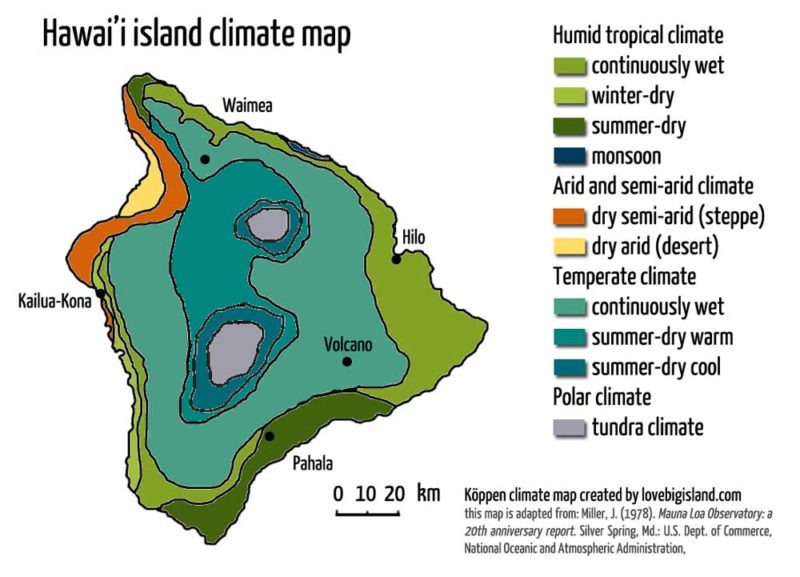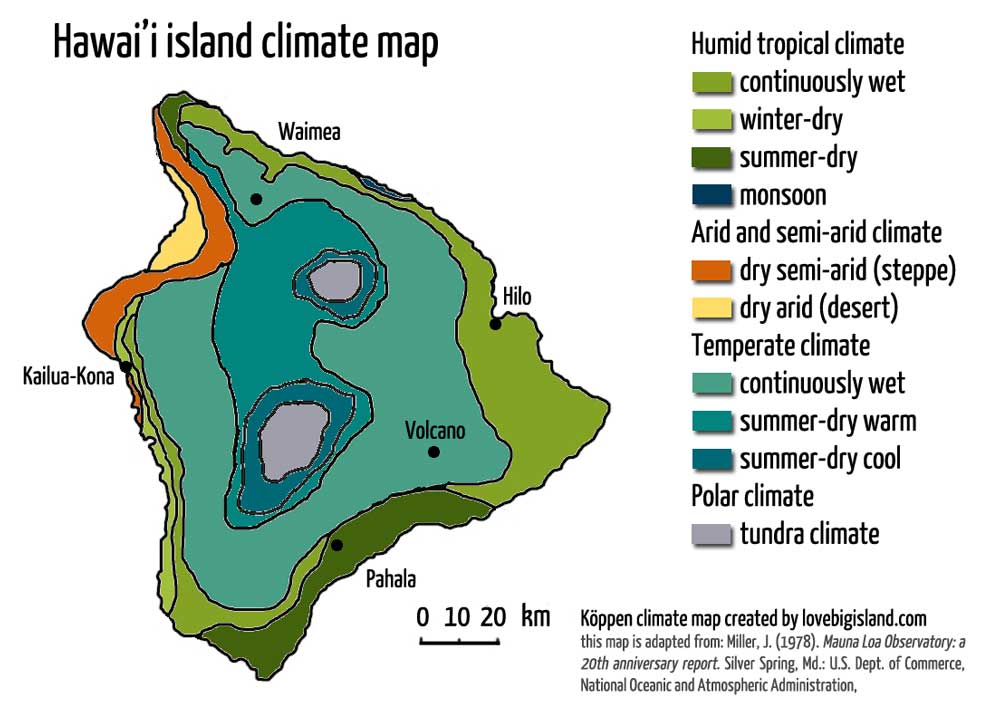Hawaii is one of the most ecologically diverse places in the world where you can find climate zones such as tropical monsoon, tundra and desert within an hour drive. This is an extraordinary feat for such a “small” (4,028 square miles surface) place and makes the Big Island even more interesting that it already is (in our slightly biased opinion).
Table of contents
Table of Contents
It also underlines one of the often repeated false quotes about Hawaii:
Hawaii has (10, 11 or 12) of the world’s 13 climate zones
This sounds like fun right, but is it also true? How many climate zones are there actually in the world? And how many of those can you find on the Big Island? Read on the learn the answer to those questions.
Spoiler alert: the quote above is not true. It is based on a misunderstanding of climate classification and sometimes on a lazy reading of figures.
There are 8 climate zones on the Big Island
The number of climate zones depends on the climate classification system that you choose. There are several of these but the most popular one in use is the Köppen climate classification scheme (Wikipedia or explained in Hydrology and Earth System Sciences). In this system there are five major climate zones that are divided into 13 sub-zones, which themselves can again be split into finer groups.
Following Köppen climate classification scheme Hawaii has 4 out of the 5 major climate zones in the world and 8 out of 13 of the sub-zones.
We marked these zones on the map below, which is based on work from J. Jurvik in the 20th-anniversary report for the Mauna Loa observatory [source]. You can see 10 different climate zones listed. However, only 8 of those are distinct ones if classified according to the Köppen system. Temperate “summer dry” and “summer cool” both belong to the temperate dry climate. Tropical “winter dry” and “summer dry” both belong to the tropical dry climate.

Climate map of the Hawaii Island showing 10 different climate zones on the Big Island. Only 8 climates are “independent”. Temperate “summer dry” and “summer cool” both belong to the temperate dry climate. Tropical “winter dry” and “summer dry” both belong to the tropical dry climate
Which climate zones are *not* on the Big Island?
There are only five climate zones that you can not find on the Big Island of Hawaii. These are:
- Winter dry (temperate climate)
- Winter dry (continental climate)
- Summer dry (continental climate)
- Continuously wet (continental climate)
- Polar ice caps (polar climate)
You can read more about both these missing climate zones, and the 8 climate zones that can be found on Hawaii, below:
The 13 climate zones of the world
You can find all five major climate zones and the 13 sub-zones they are split into below. We also list whether this climate zone can be found in Hawaii as well as the color that identifies it on our climate map.
Humid Tropical climate
In these climates all months have average temperatures greater than 64° F (18° C) and an annual precipitation is greater than 1500 mm. There are 3 sub-zones in this climate types and their designation is based on the seasonal distribution of rainfall:
- Continuously wet. No dry season, at least 60 mm of rainfall in the driest month. Color on the map
- Monsoon. Short dry season but sufficient moisture to keep the ground wet throughout the year. Color on the map
- Dry. Distinct dry season. One month with precipitation less than 60 mm. This zone can be split in “summer-dry” and “winter-dry”. Color on the map for “winter-dry”, color on the map for “summer-dry”
Example of this climate zone on the Big Island: The lush and tropical Hamakua coast.
Dry (arid and semi-arid) climate
In this climate the annual evaporation exceeds annual precipitation. The two main sub classes refer to the dominant vegetation types: steppe and desert.
- Dry arid (desert) is a true desert climate where evaporation rates are at least twice as high as the precipitation. It covers 12% of the Earth’s land surface. Color on the map
- Dry semi-arid (steppe) is a grassland climate that covers 14% of the Earth’s land surface. It receives more precipitation than the desert climate. Color on the map
Example of this climate zone on the Big Island: Kua Bay, which is our favorite white sand beach on the island.
Temperate climate
The average temperature of the coldest month is between 64° F (18° C) and 27° F (-3° C), and average temperature of warmest month > 50° F (10° C). The main subdivisions include:
- Winter dry. At least 10 times as much precipitation in the wettest month of summer as in driest month of winter (not in Hawaii).
- Summer dry. At least three times as much rain in the wettest month of winter as in driest month of summer. The driest month should have less than 30mm precipitation. On our map it is divided in a warm and cool climate. Color on the map for the cool climate. Color on the map for the warm climate
- Continuously wet. At least 30 mm precipitation in the driest month. The difference between the wettest and driest month is less than for the above two climates. Color on the map
Example of this climate zone on the Big Island: Volcano Village, which hosts temperate rainforests that make you feel like you are in Jurassic park!
Continental (cold) climate (not in Hawaii)
Continental climates have warm to cool summers and cold winters. The average temperature of the warmest month is greater than 50° F (10° C), while the coldest month is less than 27° F (-3° C). The main subdivisions are the same as those for the temperate climate:
- Winter dry. At least 10 times as much precipitation in the wettest month of summer as in driest month of winter (not in Hawaii).
- Summer dry. At least three times as much rain in the wettest month of winter as in driest month of summer. The driest month should have less than 30mm precipitation (not in Hawaii).
- Continuously wet. At least 30 mm precipitation in the driest month. The difference between the wettest and driest month is less than for the above two climates (not in Hawaii).
We don’t like cold winters that much and are not sorry to say that the Big Island does not host any continental climate zone :D
Polar climate
Polar climates are characterized by average temperatures below 50° F (10° C) during every month of the year. This climate can be split into two sub-climates:
- Polar tundra. Permanently frozen soil to depths of hundreds of meters with an average temperature between 32° F (0° C) and 50° F (10° C) during the warmest month. Color on the map
- Polar ice caps. Surface permanently covered by snow and ice. Average monthly temperature is below 32° F (0° C) during the whole year (not in Hawaii).
Surprise! We do have a polar tundra climate on the Big Island on the summits of both Mauna Kea and Mauna Loa.
Here is another fun piece of trivia: during the last 300.000 years there have been at least 4 glacial periods on the island during which the summits were covered with glaciers (source). The last of these periods ended only 9000 years ago.
Weather on the Big Island
So what do all these climates mean for your visit to the Big Island? Nothing but good news: you will find good warm weather year round. It might be a bit rainy if you are spending time on the east coast or get cool at night if you are staying at higher elevations, but that’s it.
Read more about the local weather in our guide: “weather on the Big Island, explained!”
disclaimer and context
The conclusion of this article that there are 8 out of the total 13 climate zones on the Big Island is based on the most common use of Köppen climate classification system. This is the most widely used and understood classification, but by far not the only one. The Köppen system itself has also changed over time (Wilcock et al. 1968 ).
The Köppen system is a 3-tier classification system with 5 main climates in the first tier (which are listed above, sometimes a 6th: “highland” is also used). These 5 main climates can be split up into 13 climate zones, and this is the amount of climate zones that we use when we say that the Big Island has 8 / 13 climate zones of the world. Finally, these 13 climate zones can be subdivided into 28 (or 30) “sub” climate zones. We have not used the 3rd tier in this article.
